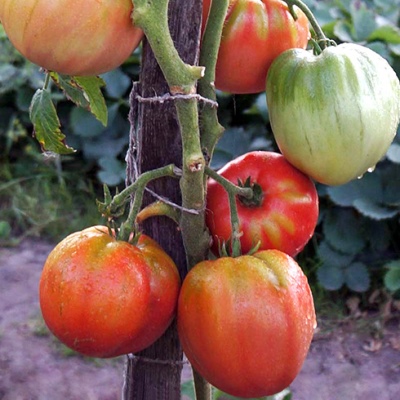
- Authors: Portugal
- Name synonyms: DaCosta's Portuguese
- Category: grade
- Growth type: indeterminate
- Appointment: universal
- Ripening time, days: in the greenhouse 110 days, in the open field - 120
- Growing conditions: for open ground, for film greenhouses
- Bush size: tall
- Bush height, cm: 120-200
- Bush characteristic: durable
Dacosta Portuguese is considered one of the best varieties of tomatoes with fruits of a pink-raspberry range. This is a collectible, rather rare variety, the seeds of which can not be seen in any garden store. However, it is enough to purchase them once - and you will be provided with material for planting, because the seeds can be used from ripe tomatoes.
Breeding history
Dacosta Portuguese - synonymous with DaCosta's Portuguese - is a varietal tomato crop that was bred by breeders from sunny Portugal. It is famous for the fact that in 2017 this crop was included in the rating list of the top ten tomato varieties.
Description of the variety
The indeterminate plant Dacosta Portuguese grows in the open field up to 120-130 cm, in a protected greenhouse - up to two meters. It is a very strong bush, medium leafy, not too sprawling, with simple inflorescences. The foliage is green, has no pubescence. The variety is grown in one or two stems.
The main qualities of the fruit
The main advantage of the Portuguese Dacosta is, of course, beautiful bright pink, according to other sources - raspberry, fruits. They are quite dense, large, grow in weight from 350 to 700 grams, sometimes up to a kilogram. There is no green spot at the base, but there may be other, lighter spots.
The fruits are round in shape, flattened on both sides, a slight pleat is observed at the stalk, but this is not necessary. Small chambers are located in all fruits, their number is 8, there are few seeds, but they are there, and they can then be used for planting. Dense juicy pulp.
Taste characteristics
The taste of Dacosta is Portuguese sweet, there is sourness, but it is weakly expressed, but a characteristic tomato rich smell is present. Delicious, aromatic, fleshy, juicy fruits are suitable for absolutely all types of use in cooking: salads, sauces, juices and other dishes. Large-fruited raspberry tomatoes are ideal for fresh consumption. True, they are not quite suitable for canning because of their huge size.
Ripening and fruiting
The culture of Portuguese selection is mid-season. The first tomatoes ripen 110-120 days after sowing seeds in the ground.
Yield
The large-fruited variety is expected to have high yields. So, from the Portuguese Dacosta bush, the lucky owners of plants in their garden collect up to 7 kg of pink fruits. And if you count it per square meter, you get as much as 20 kg of tomatoes.
The timing of planting seedlings and planting in the ground
The Dacosta Portuguese tomato is grown exclusively through seedlings. Sowing dates will vary depending on the climatic zone:
- territories in the south - in the last days of April;
- in the middle lane - after April 15;
- in the north - the first April numbers.
If greenhouse planting will be carried out, you should start with sowing seedlings 2 weeks earlier.

Growing tomato seedlings is an extremely important process, because it largely depends on whether the gardener will be able to harvest at all. All aspects must be taken into account, from seedbed preparation to planting in the ground.
Landing scheme
The number of plants planted in an area of 1 m2 will depend on the number of trunks left on the bush. If a single-stem plant is grown, up to 4 bushes are placed on the square, if in two trunks - 3.

Growing and care
Dacosta Portuguese can be planted in a garden bed only when the ground is warmed up to a distance of 15 centimeters in depth. Still it is necessary, the risk of recurrent frosts has passed. Before planting, the seedlings should be between 45 and 55 days old.
When choosing a territory for tomatoes, it is advisable to place them in a well-lit area. The beds with Portuguese Dakosta are not placed where groundwater passes rather close, and also if plants of the Solanaceae family grew on the site before. The best predecessors of tomatoes are melons and gourds.
It will be useful to apply a number of fertilizers before planting, such as humus, as well as manure (but only the one that has already been overfilled), chicken droppings. If the soil has a higher acidity than necessary, it is corrected with ash, mixing it into the soil.
Tall bushes of Portuguese Dacosta must be tied up. It is best to use a synthetic thread - it does not rot.
Water the culture if the soil dries up, at the rate of 2-3 liters of liquid per plant.
Dacosta Portuguese reacts to any feeding. If you regularly apply fertilizers, feeding the bushes every 2 weeks, the tomatoes of the variety will be both larger and more delicious.




A plant needs different micronutrients at each stage of growth. All fertilizers can be divided into two groups: mineral and organic. Folk remedies are often used: iodine, yeast, bird droppings, eggshells.
It is important to observe the rate and period of feeding. This also applies to folk remedies and organic fertilizers.



























































































